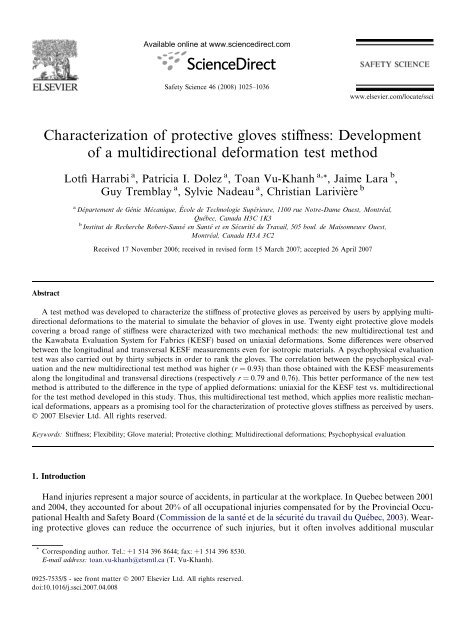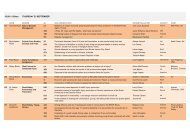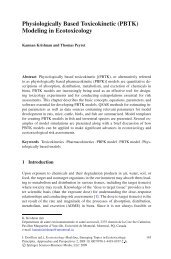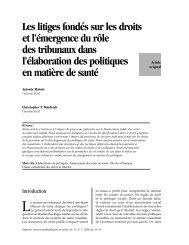Characterization of protective gloves stiffness: Development of a ...
Characterization of protective gloves stiffness: Development of a ...
Characterization of protective gloves stiffness: Development of a ...
You also want an ePaper? Increase the reach of your titles
YUMPU automatically turns print PDFs into web optimized ePapers that Google loves.
<strong>Characterization</strong> <strong>of</strong> <strong>protective</strong> <strong>gloves</strong> <strong>stiffness</strong>: <strong>Development</strong><br />
<strong>of</strong> a multidirectional deformation test method<br />
Abstract<br />
Lotfi Harrabi a , Patricia I. Dolez a , Toan Vu-Khanh a, *, Jaime Lara b ,<br />
Guy Tremblay a , Sylvie Nadeau a , Christian Larivière b<br />
a Département de Génie Mécanique, École de Technologie Supérieure, 1100 rue Notre-Dame Ouest, Montréal,<br />
Québec, Canada H3C 1K3<br />
b Institut de Recherche Robert-Sauvé en Santé et en Sécurité du Travail, 505 boul. de Maisonneuve Ouest,<br />
Montréal, Canada H3A 3C2<br />
Received 17 November 2006; received in revised form 15 March 2007; accepted 26 April 2007<br />
A test method was developed to characterize the <strong>stiffness</strong> <strong>of</strong> <strong>protective</strong> <strong>gloves</strong> as perceived by users by applying multidirectional<br />
deformations to the material to simulate the behavior <strong>of</strong> <strong>gloves</strong> in use. Twenty eight <strong>protective</strong> glove models<br />
covering a broad range <strong>of</strong> <strong>stiffness</strong> were characterized with two mechanical methods: the new multidirectional test and<br />
the Kawabata Evaluation System for Fabrics (KESF) based on uniaxial deformations. Some differences were observed<br />
between the longitudinal and transversal KESF measurements even for isotropic materials. A psychophysical evaluation<br />
test was also carried out by thirty subjects in order to rank the <strong>gloves</strong>. The correlation between the psychophysical evaluation<br />
and the new multidirectional test method was higher (r = 0.93) than those obtained with the KESF measurements<br />
along the longitudinal and transversal directions (respectively r = 0.79 and 0.76). This better performance <strong>of</strong> the new test<br />
method is attributed to the difference in the type <strong>of</strong> applied deformations: uniaxial for the KESF test vs. multidirectional<br />
for the test method developed in this study. Thus, this multidirectional test method, which applies more realistic mechanical<br />
deformations, appears as a promising tool for the characterization <strong>of</strong> <strong>protective</strong> <strong>gloves</strong> <strong>stiffness</strong> as perceived by users.<br />
Ó 2007 Elsevier Ltd. All rights reserved.<br />
Keywords: Stiffness; Flexibility; Glove material; Protective clothing; Multidirectional deformations; Psychophysical evaluation<br />
1. Introduction<br />
Available online at www.sciencedirect.com<br />
Safety Science 46 (2008) 1025–1036<br />
Hand injuries represent a major source <strong>of</strong> accidents, in particular at the workplace. In Quebec between 2001<br />
and 2004, they accounted for about 20% <strong>of</strong> all occupational injuries compensated for by the Provincial Occupational<br />
Health and Safety Board (Commission de la santé et de la sécurité du travail du Québec, 2003). Wearing<br />
<strong>protective</strong> <strong>gloves</strong> can reduce the occurrence <strong>of</strong> such injuries, but it <strong>of</strong>ten involves additional muscular<br />
* Corresponding author. Tel.: +1 514 396 8644; fax: +1 514 396 8530.<br />
E-mail address: toan.vu-khanh@etsmtl.ca (T. Vu-Khanh).<br />
0925-7535/$ - see front matter Ó 2007 Elsevier Ltd. All rights reserved.<br />
doi:10.1016/j.ssci.2007.04.008<br />
www.elsevier.com/locate/ssci
1026 L. Harrabi et al. / Safety Science 46 (2008) 1025–1036<br />
constraints and reduced dexterity, two side-effects related to the glove’s material <strong>stiffness</strong> (Bishu and Muralidhar,<br />
1999; Buhmann et al., 2000; Cadoret and Smith, 1996). Furthermore, increased muscular constraints due<br />
to <strong>protective</strong> <strong>gloves</strong> have been associated to tendinitis (Chaffin et al., 1999). As a consequence, workers may<br />
choose not to wear <strong>protective</strong> <strong>gloves</strong>, exposing themselves to high risks <strong>of</strong> hand injuries.<br />
Stiffness is one <strong>of</strong> the major properties that define how a glove interferes with the worker’s ability to perform<br />
his tasks. Studies considering the biomechanical aspects <strong>of</strong> <strong>protective</strong> <strong>gloves</strong> use the effect <strong>of</strong> wearing<br />
<strong>gloves</strong> on the deployment <strong>of</strong> the maximum grip force (Kovacs et al., 2002; Mital et al., 1994; Nelson and<br />
Mital, 1995; Rock et al., 2001; Sudhakar et al., 1988). According to Mital et al. (1994), wearing <strong>protective</strong><br />
<strong>gloves</strong> reduces the maximum gripping force by 7–30%. A recent study confirms this interval (5–23%) for a<br />
whole range <strong>of</strong> glove models (Rock et al., 2001). However, this type <strong>of</strong> evaluation requires for the subject<br />
to exert several maximum muscular contractions, thus limiting the number <strong>of</strong> contractions in each measurement<br />
session and asking for very fit subjects. Moreover, procedures involving the use <strong>of</strong> human subjects are<br />
prone to high levels <strong>of</strong> inter individual variability, leading to large uncertainty in the measurements.<br />
Several mechanical test methods have been used for characterizing film and fabric flexibility. Most <strong>of</strong> them<br />
are based on uniaxial bending, which may not be representative <strong>of</strong> the type <strong>of</strong> deformations subjected to a<br />
glove in usage. For example, the Kawabata Evaluation System for Fabrics (KESF) includes a test measuring<br />
the bending moment <strong>of</strong> a strip <strong>of</strong> material as a function <strong>of</strong> its curvature, thus providing the uniaxial bending<br />
rigidity which is proportional to the material <strong>stiffness</strong> (Kawabata, 1980). On the other side, the test method<br />
used in the ISO 5979 standard (1982) measures the uniaxial flexibility <strong>of</strong> elastomer coated textile fabrics; its<br />
principle consists in forming a loop with the material, the maximum height formed by this loop being proportional<br />
to the material <strong>stiffness</strong>. Finally, in the ASTM D 1388 standard (1996), which characterizes the flexibility<br />
properties <strong>of</strong> fabrics, the bending length is measured according to two procedures, the cantilever test and<br />
the heart loop test, which allows the flexural rigidity to be calculated.<br />
When <strong>protective</strong> <strong>gloves</strong> are worn, they are subjected to uniaxial deformations as well as equibiaxial ones, as<br />
can be seen in Fig. 1. Stiffness measured with a uniaxial deformation test may not describe well the glove performance<br />
in service. <strong>Characterization</strong> methods making use <strong>of</strong> multidirectional deformations are thus required.<br />
The test method used in the ASTM D 4032 standard (1994) makes use <strong>of</strong> a circular bend procedure for<br />
measuring the <strong>stiffness</strong> <strong>of</strong> fabrics, thus creating multidirectional deformations. A flat headed cylindrical probe<br />
forces a folded piece <strong>of</strong> the fabric sample through an orifice in a platform. The maximum force required to<br />
push the fabric through the orifice is measured and can be used as an indication <strong>of</strong> the fabric <strong>stiffness</strong>. Some<br />
authors have calculated the work corresponding to the entire passing <strong>of</strong> the piece <strong>of</strong> fabric through the orifice,<br />
which is proportional to the material <strong>stiffness</strong> (Killinc-Balci, 2004). However, the much larger thickness <strong>of</strong><br />
<strong>gloves</strong>, in particular considering the presence <strong>of</strong> fingers, prevents the use <strong>of</strong> this method as it is. In addition,<br />
the flat headed shape <strong>of</strong> the probe does not generate deformations typical <strong>of</strong> what is sustained by <strong>gloves</strong> in use<br />
and may create unnecessary stress concentration.<br />
In this study, we propose a new multidirectional test method, inspired from the ASTM D 4032 standard<br />
method, which allows for the measurement <strong>of</strong> <strong>protective</strong> <strong>gloves</strong> <strong>stiffness</strong>. This new method is described below<br />
as the free-deforming multidirectional technique and has been used to measure the <strong>stiffness</strong> <strong>of</strong> 28 models <strong>of</strong><br />
Fig. 1. Folds (a) and biaxial deformations (b) <strong>of</strong> worn <strong>protective</strong> <strong>gloves</strong>.
<strong>protective</strong> <strong>gloves</strong>. For a comparison, the <strong>stiffness</strong> <strong>of</strong> these <strong>gloves</strong> was also characterized by the KESF along<br />
both directions (longitudinal and transversal).<br />
Since the perception <strong>of</strong> users is a major contributor to <strong>protective</strong> glove wearing, the <strong>stiffness</strong> measurements<br />
provided by both mechanical methods, the developed free-deforming multidirectional technique and the<br />
KESF, have been compared to the results <strong>of</strong> a psychophysical evaluation test in which human subjects had<br />
to rank the <strong>gloves</strong> according to their <strong>stiffness</strong>. Considering that stiffer <strong>gloves</strong> involve an increase in the forearm<br />
muscle activation (Lariviere et al., 2004), the perceived exertion should change accordingly. Effectively, it is<br />
well known that muscle activation and the rating <strong>of</strong> perceived exertion are associated (Jones and Hunter,<br />
1982). Thus, the well recognized psychophysical bases <strong>of</strong> perceived exertion (Borg, 1998) will be used to verify<br />
whether the mechanical tests <strong>of</strong> glove <strong>stiffness</strong> have some ecological (external) validity.<br />
2. Materials and methods<br />
Table 1 presents the characteristics and manufacturers <strong>of</strong> the 28 unsupported and supported <strong>protective</strong><br />
glove models used in this study. These <strong>gloves</strong> were subjectively selected between hundred commercially available<br />
<strong>gloves</strong> models, in order to include representatives from the most flexible to the most rigid material groups.<br />
2.1. The KESF uniaxial bending approach<br />
L. Harrabi et al. / Safety Science 46 (2008) 1025–1036 1027<br />
The KESF is used in the textile industry to characterize the mechanical properties and the surface condition<br />
<strong>of</strong> fabrics (Kawabata, 1980; Saville, 1999). It includes a measurement <strong>of</strong> the material <strong>stiffness</strong>, which is based<br />
on a uniaxial bending test. The whole sample is bent from 2.5 to 2.5 cm 1 in an arc <strong>of</strong> constant curvature (see<br />
Fig. 2a). The bending moment required to produce this curvature is continuously monitored. The bending<br />
Table 1<br />
Characteristics <strong>of</strong> the tested <strong>protective</strong> <strong>gloves</strong><br />
Manuf. Model Materials Thickness (mm)<br />
Ansell Canners and Handlers # 392 Natural rubber (NR) 1.1<br />
Best Nitri-Solve Ò 747 Nitrile 1.2<br />
Best The Original Nitri-Flex Ò 4000P Nitrile on cotton knit 1.7<br />
Best Nitri-Pro Ò 7000P Nitrile on cotton knit 1.7<br />
Ansell Hyflex 11-900 Nitrile on cotton knit 2<br />
Best Natural Rubber Latex HD Ò 55 Natural rubber (NR) 2.1<br />
Ansell Hycron 27-607 Nitrile/cotton knit 2.6<br />
Best Ultraflex Nitrile Ò 22-R Nitrile/cotton knit 2.6<br />
Ansell Golden Grab It 16-300 Leather and NR/cotton knit 3.2<br />
Ansell Scorpio 8-352 Neoprene on cotton knit 3.3<br />
Best Neo Hyde Ò 361 PVC on cotton knit 3.3<br />
Ansell Grab It Safe 28-362 NR/Kevlar/cotton knit 3.4<br />
Ansell Seams-Rite 20-115 Vinyl coated, jersey lined 3.6<br />
Best Cannonball Ò 803 PVC/jersey lining 3.6<br />
Ansell Snorkel 4-412 PVC/Nitrile/jersey knit 3.6<br />
Ansell PowerFlex 80-100 NR on cotton knit 3.6<br />
Best KPG Ò 960 PVC on cotton knit 3.7<br />
Ansell Hyd Tur 52-547 Nitrile/jersey lining 3.7<br />
Best Cannonball Ò 812M PVC/jersey lining 3.8<br />
Ansell Grab It 6-620 NR/Cotton Jersey 4.1<br />
Best Skinny Dip Aramid Ò 4811 NR on Kevlar aramid knit 4.3<br />
Ansell the Duke 70-982 Rubber coated knit jersey 4.4<br />
Ansell Crusader 42-325 Nitrile on non woven felt 4.5<br />
Ansell GoldKnit Kevlar 70-225 Kevlar knit 4.5<br />
Best Neo Grab Ò 6780-R Neoprene/insulating lining 4.8<br />
Ansell Winter Monkey Grip 23-193 PVC on jersey lining 6.4<br />
Ansell Neox 9-022 Neoprene on cotton 6.4<br />
Best Insulated snowman 2950 Nitrile coated, fleece lining 8.6
1028 L. Harrabi et al. / Safety Science 46 (2008) 1025–1036<br />
Curvature<br />
radius<br />
Sample<br />
rigidity is calculated as the slope <strong>of</strong> the curve <strong>of</strong> the bending moment expressed as a function <strong>of</strong> the curvature<br />
as illustrated in Fig. 2b. Since this measurement involves uniaxial deformations and since textiles, which are<br />
included in most <strong>of</strong> the <strong>gloves</strong>, are generally anisotropic materials, i.e. with physical properties different in each<br />
direction, <strong>gloves</strong> were tested along both main directions.<br />
The bending rigidity was measured on samples taken in the glove palm along the longitudinal and transversal<br />
directions. For each glove model, three replicas were measured, allowing for the calculation <strong>of</strong> a mean<br />
and a standard deviation.<br />
2.2. The free-deforming multidirectional test method<br />
Bending<br />
moment<br />
(μN.m/m)<br />
Fig. 2. Bending rigidity with the KESF method.<br />
Curvature<br />
(m -1 )<br />
The principle <strong>of</strong> the free-deforming multidirectional test method is based on the use <strong>of</strong> a probe to push a<br />
sample through an orifice drilled in a platform (see Fig. 3). The lap edge <strong>of</strong> the orifice is chamfered to limit<br />
stress concentration. Because <strong>of</strong> the larger thickness <strong>of</strong> <strong>gloves</strong> compared to fabrics, the value <strong>of</strong> the gap<br />
between the probe head and orifice diameters has been almost doubled, the probe and orifice diameters being<br />
respectively equal to 35.8 mm and 57.0 mm. In order to limit the stress concentration at the probe head and to<br />
better simulate the type <strong>of</strong> deformations applied to <strong>gloves</strong> while in use, the probe head includes a conical section<br />
with an angle <strong>of</strong> 30° and an 11.56-mm-radius spherical tip. This geometry produces double curvature<br />
deformations (Laroche and Vu-Khanh, 1993). To account for the influence <strong>of</strong> the glove fingers, the diameter<br />
<strong>of</strong> the probe is maintained at a constant value up to the top, as illustrated in Fig. 4, which displays the experimental<br />
set-up inserted into an 1137 Instron tensile testing frame with a glove positioned palm up above the<br />
orifice.<br />
The force–displacement curve is recorded while the glove, positioned palm up laying on the platform with<br />
its palm centered above the orifice, is pushed through it by the probe traveling at a rate <strong>of</strong> 100 mm/min.<br />
Fig. 3. Schematic representation <strong>of</strong> the free-deforming multidirectional method set-up.
Fig. 4. Picture <strong>of</strong> the experimental set-up <strong>of</strong> the free-deforming multidirectional test method.<br />
Force (N)<br />
7<br />
6<br />
5<br />
4<br />
3<br />
2<br />
1<br />
0<br />
L. Harrabi et al. / Safety Science 46 (2008) 1025–1036 1029<br />
0 2 4 6 8 10 12 14 16<br />
Probe displacement (cm)<br />
Fig. 5. Typical force displacement curve measured as the entire glove is passed through the orifice.<br />
A typical example <strong>of</strong> the obtained force vs. displacement curve is shown in Fig. 5. During the first part <strong>of</strong> the<br />
probe displacement, the force increases regularly, then reaches a maximum and decreases rapidly. For each<br />
model, five different <strong>gloves</strong> were measured, allowing for the calculation <strong>of</strong> mean and standard deviation<br />
values.<br />
Three types <strong>of</strong> data analysis were performed on the force–displacement data recorded with the freedeforming<br />
multidirectional test method. First, the maximum force was measured. Second, the total work<br />
needed to push the glove through the hole was given by the surface area <strong>of</strong> the force vs. displacement curve.<br />
This work is proportional to the energy <strong>of</strong> deformation <strong>of</strong> the glove, itself proportional to the material <strong>stiffness</strong><br />
(Killinc-Balci, 2004).<br />
Third, in order to enlarge the range <strong>of</strong> measurable <strong>stiffness</strong> values and to limit the effect <strong>of</strong> glove friction on<br />
the orifice edge surface, the calculation <strong>of</strong> the work on the first 10-mm <strong>of</strong> deformation <strong>of</strong> the glove was<br />
performed. This distance corresponds to half <strong>of</strong> the height <strong>of</strong> the conical–spherical probe head. Figs. 6 and<br />
7 display schematic representations <strong>of</strong> the two set-up configurations between which the initial work is calculated.<br />
At configuration 0 (Fig. 6), the two layers corresponding to both sides <strong>of</strong> the glove are not deformed and<br />
are touching each other. At configuration 1 (Fig. 7), the probe has traveled a distance <strong>of</strong> 10 mm. The total<br />
glove thickness was measured at the center <strong>of</strong> the palm and this value was used to adjust the zero <strong>of</strong> the measurement<br />
versus the upper lap <strong>of</strong> the platform.<br />
Fig. 8 displays examples <strong>of</strong> the initial part <strong>of</strong> the force–displacement curve obtained for two different glove<br />
models. The calculation <strong>of</strong> the initial work was performed between these 10-mm-distant integration limits<br />
identified as 0 and 1 and corresponding to the configurations illustrated in Figs. 6 and 7.
1030 L. Harrabi et al. / Safety Science 46 (2008) 1025–1036<br />
Force (N)<br />
25<br />
20<br />
15<br />
10<br />
2.3. The psychophysical evaluation test<br />
5<br />
0<br />
0<br />
Fig. 6. Configuration 0: palm and back sides in contact.<br />
Fig. 7. Configuration 1: 10-mm deformation <strong>of</strong> the glove.<br />
Ansell Neox 9-022<br />
Best UltraFlex 22-R<br />
10 mm<br />
0 2 4 6 8 10 12 14<br />
Displacement (mm)<br />
Fig. 8. Examples <strong>of</strong> the initial part <strong>of</strong> the force displacement curve for two models <strong>of</strong> <strong>protective</strong> <strong>gloves</strong> illustrating the calculation <strong>of</strong> the<br />
initial work.<br />
A psychophysical evaluation <strong>of</strong> the glove <strong>stiffness</strong> was performed by thirty healthy human subjects, naive<br />
relative to this kind <strong>of</strong> evaluation, aged between 20 and 55 and selected on a voluntary basis. Each subject had<br />
1
to classify the <strong>gloves</strong> using a scale from 1 to 10 (1 being the most flexible and 10 the stiffest). The test was<br />
adapted from the CR-10 Borg scale (Borg, 1998), with excluding the score 0 which corresponds to the absence<br />
<strong>of</strong> constraint, i.e. the bare hand condition, and forcing the subject to select at least once the scores 1 and 10,<br />
which ensures an optimal discrimination between the <strong>gloves</strong>. In fact, the rating <strong>of</strong> perceived exertion using the<br />
CR-10 Borg scale would have likely produced values lower than 5 because numbers are anchored by verbal<br />
expression, with a 10 meaning ‘‘very, very strong” exertion (almost max) and a 5 meaning ‘‘strong” exertion.<br />
The procedure included two steps. First, the subject had to try on all the <strong>gloves</strong> one by one in order to rank<br />
them according to their <strong>stiffness</strong>. It allowed identifying the two anchoring points <strong>of</strong> the distribution, i.e. the<br />
most flexible glove (level 1) and the stiffest glove (level 10). Clear instructions were provided that the <strong>gloves</strong><br />
had to be evaluated according to their <strong>stiffness</strong> and not based on comfort, size or any other property. However,<br />
apart from moving the fingers, no particular task was requested or suggested for the evaluation <strong>of</strong> the<br />
glove <strong>stiffness</strong>. Then, the subject had to attribute to each <strong>of</strong> the remaining <strong>gloves</strong> a number between 1 and<br />
10 inclusively according to its level <strong>of</strong> <strong>stiffness</strong>. In other words, no verbal expressions were used to anchor<br />
the values from 1 to 10. In order to allow for an iterative evaluation procedure, the <strong>gloves</strong> were placed by<br />
the subject in baskets numbered 1 to 10 corresponding to their level <strong>of</strong> <strong>stiffness</strong>. It was specified that the subject<br />
could put two or more <strong>gloves</strong> in one basket if evaluated <strong>of</strong> the same <strong>stiffness</strong> and that some baskets may contain<br />
no glove. The time and the number <strong>of</strong> trials for each glove were not restricted. In general, an average <strong>of</strong><br />
20–30 min was necessary for the subjects to sort the <strong>gloves</strong>.<br />
One model <strong>of</strong> the list <strong>of</strong> 28 <strong>gloves</strong> displayed in Table 1 could not be included in the psychophysical<br />
evaluation test because the insufficient number <strong>of</strong> <strong>gloves</strong> available prevented providing each subject with<br />
a new specimen.<br />
3. Results and discussion<br />
3.1. The KESF uniaxial bending approach<br />
The 28 <strong>protective</strong> <strong>gloves</strong> have been characterized with the KESF bending technique. The results are<br />
displayed in the form <strong>of</strong> a histogram in Fig. 9. For two glove models, it was not possible to carry out the<br />
Bending rigidity (μN.m)<br />
14<br />
12<br />
10<br />
8<br />
6<br />
4<br />
2<br />
0<br />
L. Harrabi et al. / Safety Science 46 (2008) 1025–1036 1031<br />
Longitudinal direction<br />
Transversal direction<br />
Ansell Hyflex 11-900<br />
Ansell Canners & Handlers #392<br />
Ansell Hyd Tur 52-547<br />
Best Nitri-Pro® 7000P<br />
Ansell GoldKnit Kevlar 70-225<br />
Ansell Seams-Rite 20-115<br />
Best Nitri-Solve® 747<br />
Best The Original Nitri-Flex® 4000P<br />
Ansell Hycron 27-607<br />
Ansell PowerFlex 80-100<br />
Best KPG® 960<br />
Ansell Grab It Safe 28-362<br />
Best Skinny Dip Aramid® 4811<br />
Best Ultraflex Nitrile® 22-R<br />
Ansell Golden Grab It 16-300<br />
Ansell Scorpio 8-352<br />
Best Cannonball®803<br />
Best Natural Rubber Latex HD®55<br />
Best Neo Hyde® 361<br />
Ansell Grab It 6-620<br />
Ansell Winter Monkey Grip 23-193<br />
Best Cannonball® 812M<br />
Ansell Crusader 42-325<br />
Ansell Snorkel 4-412<br />
Best Neo Grab® 6780-R<br />
Ansell Neox 9-022<br />
Fig. 9. Measured bending rigidity along the longitudinal and transversal directions with the KESF technique.
1032 L. Harrabi et al. / Safety Science 46 (2008) 1025–1036<br />
measurements because <strong>of</strong> limitations related to the glove thickness and/or design. Except for a few exceptions,<br />
the measured bending rigidity exhibits small standard deviations, indicative <strong>of</strong> the good reproducibility <strong>of</strong> the<br />
results. The data are spread over more than a decade <strong>of</strong> lN m, thus allowing for an easy separation <strong>of</strong> the<br />
glove performance in terms <strong>of</strong> <strong>stiffness</strong>.<br />
The comparison between the measurements performed along the longitudinal and transversal directions <strong>of</strong><br />
the <strong>gloves</strong> shows some varied behaviors. For some <strong>of</strong> the <strong>gloves</strong>, the values <strong>of</strong> bending rigidity in the longitudinal<br />
and transversal directions are identical within the measurement uncertainty. However, for other glove<br />
models, the values measured in the longitudinal and transversal directions may differ by a factor <strong>of</strong> 2 or more.<br />
While differences between the warp and weft directions are expected for anisotropic materials like knit or<br />
woven fabrics and for composites including a textile liner, large discrepancies between the measurements performed<br />
along the glove longitudinal and transversal directions are also observed for <strong>gloves</strong> made <strong>of</strong> pure elastomer,<br />
reaching 50% for example in the case <strong>of</strong> the natural rubber Best HD 55 <strong>gloves</strong>. These sometimes large<br />
differences obtained for longitudinal and transversal bending rigidity translate into major discrepancies<br />
between the glove rankings based on their <strong>stiffness</strong> along the longitudinal and transversal directions, up to<br />
eight places for a total <strong>of</strong> 26.<br />
3.2. The free-deforming multidirectional test method<br />
The 28 selected models <strong>of</strong> <strong>protective</strong> <strong>gloves</strong> were tested with this free-deforming multidirectional method.<br />
For the ten less stiff <strong>gloves</strong>, the maximum force and the total work were obtained (Harrabi et al., 2006). Both<br />
parameters lead to the same ranking <strong>of</strong> the <strong>gloves</strong> on a <strong>stiffness</strong> scale. This can be seen as an indication <strong>of</strong> the<br />
usefulness <strong>of</strong> the work as a parameter for characterizing the material <strong>stiffness</strong> as well as <strong>of</strong> the validity <strong>of</strong> the<br />
technique principles.<br />
The results in terms <strong>of</strong> initial work are provided in Fig. 10 in the form <strong>of</strong> a histogram for the 28 models <strong>of</strong><br />
<strong>gloves</strong>. It can be seen that the data are spread over more than a decade <strong>of</strong> N mm and display a good reproducibility<br />
as shown by the low standard deviation values. A comparison <strong>of</strong> the <strong>stiffness</strong> ranking <strong>of</strong> the ten less<br />
stiff <strong>gloves</strong> based on the maximum force and total work with that based on the initial work shows a good<br />
agreement between the different methods <strong>of</strong> data analysis (Vu-Khanh et al., in press). The slight differences<br />
Work on the first 10-mm glove deformation<br />
(N.mm)<br />
350<br />
300<br />
250<br />
200<br />
150<br />
100<br />
50<br />
0<br />
Class 1<br />
Class 2<br />
Class 3<br />
Class 4<br />
Class 5<br />
Class 6<br />
Ansell Hyflex 11-900<br />
Ansell Canners & Handlers # 392<br />
Ansell GoldKnit Kevlar 70-225<br />
Best Nitri-Solve® 747<br />
Ansell PowerFlex 80-100<br />
Best The Original Nitri-Flex® 4000P<br />
Best Skinny Dip Aramid® 4811<br />
Best Natural Rubber Latex HD® 55<br />
Best KPG® 960<br />
Ansell Hyd Tur 52-547<br />
Best Nitri-Pro® 7000P<br />
Ansell Golden Grab It 16-300<br />
Ansell The Duke 70-982<br />
Ansell Seams-Rite 20-115<br />
Ansell Hycron 27-607<br />
Ansell Grab It Safe 28-362<br />
Best Ultraflex Nitrile® 22-R<br />
Best Cannonball® 803<br />
Best Cannonball® 812M<br />
Ansell Grab It 6-620<br />
Ansell Scorpio 8-352<br />
Ansell Winter Monkey Grip 23-193<br />
Best Insulated Snowman 2950<br />
Ansell Crusader 42-325<br />
Ansell Snorkel 4-412<br />
Best Neo Hyde® 361<br />
Best Neo Grab® 6780-R<br />
Ansell Neox 9-022<br />
Fig. 10. Initial work using the free-deforming multidirectional method.
that are observed can be attributed to the large friction coefficient <strong>of</strong> some models <strong>of</strong> <strong>gloves</strong>, which contributes<br />
in a larger extent to the maximum force and total work measurement than to the initial work.<br />
Using the initial work, it is possible to divide the 28 tested <strong>gloves</strong> in six classes within which similar levels <strong>of</strong><br />
<strong>stiffness</strong> are observed. They are illustrated in Fig. 10. Class 1 corresponds to the most flexible <strong>gloves</strong>, with an<br />
initial work between 5 and 20 N m, Class 2 between 20 and 50 N m, Class 3 between 50 and 80 N m, Class 4<br />
between 80 and 120 N m, Class 5 between 120 and 170 N m and Class 6 for the stiffest measured <strong>gloves</strong>, i.e.<br />
between 200 and 350 N m.<br />
3.3. Comparison <strong>of</strong> the results <strong>of</strong> the mechanical methods with a psychophysical evaluation test<br />
The results obtained with both mechanical test methods were compared with the rating provided by the<br />
psychophysical test for the 25 models <strong>of</strong> <strong>gloves</strong> characterized by all three methods. Fig. 11 displays the relationship<br />
between the <strong>stiffness</strong> <strong>of</strong> the <strong>gloves</strong> measured with the multidirectional method using the initial work<br />
and the result <strong>of</strong> the psychophysical evaluation test. Standard deviations obtained for the glove rating using<br />
the psychophysical evaluation test, not shown for clarity purpose, are situated between 0.3 and 2.5. The data<br />
points can be described by an exponential function with a correlation <strong>of</strong> 0.92. When results from the KESF<br />
measurements along the longitudinal and transversal directions are plotted as a function <strong>of</strong> the psychophysical<br />
evaluation test rating, the association is less satisfactory, with correlation coefficients <strong>of</strong> respectively 0.79 and<br />
0.81.<br />
Correlations between the sets <strong>of</strong> measurements were also calculated. Since scores provided by the KESF<br />
and multidirectional methods are not normally distributed, Spearman’s rank correlation method was used,<br />
in which data are converted to ranks before the calculation is carried out. It is illustrated in Figs. 12–14<br />
for the association between the psychophysical evaluation rating and respectively the KESF measurements<br />
along the longitudinal and transversal directions and the free-deforming multidirectional method results. Significant<br />
correlations are obtained in all cases. Correlations between the mechanical methods are good ( 0.85).<br />
However, the results <strong>of</strong> the multidirectional method are more correlated to the psychophysical evaluation<br />
(r = 0.93) than the different indices produced by the KESF (r = 0.79 for the measurements along the longitu-<br />
Stiffness according to the free-deforming<br />
multidirectional method (N.mm)<br />
300<br />
250<br />
200<br />
150<br />
100<br />
50<br />
L. Harrabi et al. / Safety Science 46 (2008) 1025–1036 1033<br />
r = 0.92<br />
0<br />
1.0 2.0 3.0 4.0 5.0 6.0 7.0 8.0 9.0 10.0<br />
Psychophysical evaluation rating<br />
Fig. 11. Association between the <strong>stiffness</strong> <strong>of</strong> the <strong>gloves</strong> measured with the multidirectional method using the initial work and the<br />
psychophysical evaluation test results.
1034 L. Harrabi et al. / Safety Science 46 (2008) 1025–1036<br />
Stiffness ranking by the KESF method along the<br />
longitudianl direction<br />
25<br />
20<br />
15<br />
10<br />
5<br />
0<br />
r = 0.79<br />
0 1 2 3 4 5 6 7 8 9 10<br />
Psychophysical evaluation rating<br />
Fig. 12. Association between the psychophysical evaluation test results and the <strong>stiffness</strong> ranking provided by the KESF measurements<br />
along the longitudinal direction.<br />
Stiffness ranking by the KESF method along the<br />
transversal direction<br />
25<br />
20<br />
15<br />
10<br />
5<br />
r = 0.76<br />
0<br />
0 1 2 3 4 5 6 7 8 9 10<br />
Psychophysical evaluation rating<br />
Fig. 13. Association between the psychophysical evaluation test results and the <strong>stiffness</strong> ranking provided by the KESF measurements<br />
along the transversal direction.<br />
dinal direction and r = 0.76 for those along the transversal direction). This shows that the free-deforming multidirectional<br />
method describes much more closely the <strong>stiffness</strong> <strong>of</strong> <strong>protective</strong> <strong>gloves</strong> as wearers perceive it.<br />
The differences observed between the results <strong>of</strong> the psychophysical evaluation test and the measurements<br />
provided by the KESF technique do not appear to be related either to the differences measured between<br />
the KESF uniaxial rigidity results along the longitudinal and transversal directions <strong>of</strong> the glove, the type <strong>of</strong><br />
material used in the composition <strong>of</strong> the glove, or the presence <strong>of</strong> a different material for the back side <strong>of</strong>
the glove than for the palm side. The better correlation between the psychophysical evaluation and the freedeforming<br />
method is thus attributed to the type <strong>of</strong> deformations subjected to the glove during the measurement,<br />
uniaxial for the KESF system test method and multidirectional for the free-deforming technique.<br />
4. Conclusions<br />
Stiffness ranking by free-deforming multidirectional<br />
method<br />
25<br />
20<br />
15<br />
10<br />
5<br />
0<br />
L. Harrabi et al. / Safety Science 46 (2008) 1025–1036 1035<br />
r = 0.93<br />
0 1 2 3 4 5 6 7 8 9 10<br />
Psychophysical evaluation rating<br />
Fig. 14. Association between the psychophysical evaluation test results and the <strong>stiffness</strong> ranking provided by the free-deforming<br />
multidirectional method.<br />
A new test method applying multidirectional deformations and using a conical spherical probe head which<br />
better simulates the type <strong>of</strong> mechanical deformations sustained by glove in use has been developed and evaluated.<br />
The <strong>stiffness</strong> <strong>of</strong> 28 models <strong>of</strong> <strong>protective</strong> <strong>gloves</strong> was measured by this new multidirectional test method<br />
and by the KESF method for fabrics that measures the uniaxial bending rigidity in both directions (longitudinal<br />
and transversal) <strong>of</strong> the <strong>gloves</strong>. It was also characterized using a psychophysical evaluation test performed<br />
with thirty subjects.<br />
Large differences in the bending rigidity measured by the KESF technique were found between the measurements<br />
along the longitudinal and transversal directions for some <strong>protective</strong> <strong>gloves</strong>, causing large differences<br />
in the <strong>stiffness</strong> rankings along the longitudinal and transversal directions. These differences can not<br />
be related to the anisotropic nature <strong>of</strong> the material since they exist even for some models <strong>of</strong> elastomer <strong>gloves</strong>.<br />
In addition, two models <strong>of</strong> <strong>gloves</strong> could not be characterized due to thickness limitations.<br />
For the free-deforming multidirectional technique, the analysis <strong>of</strong> the force–displacement curves in terms <strong>of</strong><br />
the initial work corresponding to the first 10 mm <strong>of</strong> deformation <strong>of</strong> the glove has allowed characterizing all 28<br />
models <strong>of</strong> <strong>protective</strong> <strong>gloves</strong> according to their <strong>stiffness</strong>. The analysis <strong>of</strong> the correlations between the glove <strong>stiffness</strong><br />
measurements produced by the two mechanical test methods and the results <strong>of</strong> a psychophysical evaluation<br />
test shows a much better agreement with the free-deforming multidirectional method, which indicates<br />
that this method describes much more closely the <strong>stiffness</strong> <strong>of</strong> <strong>protective</strong> <strong>gloves</strong> as wearers perceive it. This<br />
can be attributed to the multidirectional deformations applied to the glove during the test, which better simulate<br />
the deformations subjected to <strong>gloves</strong> in service. Using the initial work values, the tested <strong>gloves</strong> have been<br />
divided into six classes corresponding to six levels <strong>of</strong> <strong>stiffness</strong>, which can be used for a selection <strong>of</strong> <strong>gloves</strong> as a<br />
function <strong>of</strong> the tasks.<br />
Two additional practical advantages <strong>of</strong> the free-deforming multidirectional technique should be mentioned:<br />
first, it is very easy to implement, the simple set-up <strong>of</strong> probe and drilled plate being inserted in a mechanical
1036 L. Harrabi et al. / Safety Science 46 (2008) 1025–1036<br />
test frame with limited requirements in terms <strong>of</strong> load capacity. Second, this method is non destructive, especially<br />
since the glove is deformed only through a 10-mm course <strong>of</strong> the probe.<br />
This new method should prove as a valuable tool for <strong>protective</strong> glove manufacturers in their search for<br />
improving their product quality, allowing for the characterization <strong>of</strong> their existing products in terms <strong>of</strong> <strong>stiffness</strong><br />
and for the development <strong>of</strong> new ones better fitting workers’ needs. In addition, if adopted as a standard in<br />
conjunction with a system <strong>of</strong> classification levels, this method will also have more direct positive repercussions<br />
on workers, since it will permit the systematic rating <strong>of</strong> <strong>protective</strong> <strong>gloves</strong> versus a universal <strong>stiffness</strong> criterion,<br />
thus allowing for an easier selection <strong>of</strong> the <strong>protective</strong> glove best fitted to the performed tasks.<br />
Acknowledgement<br />
This research has been supported by the Institut de recherche Robert-Sauvé en santé et en sécurité du<br />
travail (IRSST), Montréal, Canada.<br />
References<br />
ASTM D 1388, 1996. Standard test method for <strong>stiffness</strong> <strong>of</strong> fabrics. Annual Book <strong>of</strong> ASTM Standards.<br />
ASTM D 4032-94, 1994. Standard test method for <strong>stiffness</strong> <strong>of</strong> fabric by circular bend procedure. Annual Book <strong>of</strong> ASTM Standards.<br />
Bishu, R., Muralidhar, A., 1999. Gloves. In: Karwowski, W., Marras, W.S. (Eds.), The Occupational Ergonomics Handbook. CRC Press,<br />
NY, pp. 865–876.<br />
Borg, G. (Ed.), 1998. Borg’s Perceived Exertion and Pain Scales. Human Kinetics, Champaign, IL, USA.<br />
Buhmann, D.C., Cherry, J.A., Bronkema-Orr, L., Bishu, R., 2000. Effect <strong>of</strong> <strong>gloves</strong>, orientation, pressure, load and handle on submaximal<br />
grasp force. International Journal <strong>of</strong> Industrial Ergonomics 25 (3), 247–256.<br />
Cadoret, G., Smith, A.M., 1996. Friction, not texture, dictates grips forces used during object manipulation. Journal <strong>of</strong> Neurophysiology<br />
75 (5), 1963–1969.<br />
Chaffin, D.B., Anderson, G., Martin, B.J. (Eds.), 1999. Occupational Biomechanics, third ed. Wiley, New York, Toronto.<br />
Commission de la santé et de la sécurité du travail du Québec, Fichier sur les lésions pr<strong>of</strong>essionnelles, updated September 2003, Montréal,<br />
QC.<br />
Harrabi, L., Dolez, P., Vu-Khanh, T., Lara, J., 2006. Evaluation <strong>of</strong> the flexibility <strong>of</strong> <strong>protective</strong> <strong>gloves</strong>. In: Proceeding <strong>of</strong> the 3rd European<br />
Conference on Protective Clothing, Gdynia, Poland, 10–12 May.<br />
ISO 5979, Rubber or plastics coated fabrics – Determination <strong>of</strong> flexibility – Flat loop method, 1982.<br />
Jones, L.A., Hunter, I.W., 1982. The relation <strong>of</strong> muscle force and EMG to perceived force in human finger flexors. European Journal <strong>of</strong><br />
Applied Physiology 50, 125–131.<br />
Kawabata, S. (Ed.), 1980. The Standardization and Analysis <strong>of</strong> Hand Evaluation. The Textile Machinery Society <strong>of</strong> Japon, Osaka.<br />
Killinc-Balci, F.S., 2004. A study <strong>of</strong> the nature <strong>of</strong> fabric comfort [dissertation]. Auburn University, Alabama.<br />
Kovacs, K.M., Splittstoesser, R., Maronitis, A., Marras, W.S., 2002. Grip force and muscle activity differences due to glove type. Journal<br />
<strong>of</strong> the American Industrial Hygiene Association 63 (3), 269–274.<br />
Lariviere, C., Plamondon, A., Lara, J., Tellier, C., Boutin, J., Dagenais, A., 2004. Biomechanical assessment <strong>of</strong> <strong>gloves</strong>. A study <strong>of</strong> the<br />
sensitivity and reliability <strong>of</strong> electromyographic parameters used to measure the activation and fatigue <strong>of</strong> different forearm muscles.<br />
International Journal <strong>of</strong> Industrial Ergonomics 34, 101–116.<br />
Laroche, D., Vu-Khanh, T., 1993. Modeling <strong>of</strong> the thermo-elastic properties <strong>of</strong> Woven fabric composites in complex shapes. Composite<br />
Materials: Testing and design, ASTM STP 1206, pp. 386–414.<br />
Mital, A., Kuo, T., Faard, H.F., 1994. A quantitative evaluation <strong>of</strong> <strong>gloves</strong> used with non-powered hand tools in routine maintenance<br />
tasks. Ergonomics 37 (2), 333–343.<br />
Nelson, J.B., Mital, A., 1995. An Ergonomic evaluation <strong>of</strong> dexterity and tactility with increase in examination/surgical glove thickness.<br />
Ergonomics 38, 723–733.<br />
Rock, K.M., Mikat, R.P., Foster, C., 2001. The effects <strong>of</strong> <strong>gloves</strong> on grip strength and three-point pinch. Journal <strong>of</strong> Hand Therapy 14 (4),<br />
286–290.<br />
Saville, B.P., 1999. Objective evaluation <strong>of</strong> fabric handle. In: The Textile Institute CRC Press (Eds.), Physical Testing <strong>of</strong> Textiles,<br />
Woodhead Publishing Limited, pp. 77–114.<br />
Sudhakar, L.R., Schoenmarklin, R.W., Lavender, S.A., Marras, W.S., 1988. The effects <strong>of</strong> <strong>gloves</strong> on grip strength and muscle activity. In<br />
Proceeding <strong>of</strong> the Human Factors Society, Santa Monica, CA, USA.<br />
Vu-Khanh, T., Dolez, P., Harrabi, L., Lara, J., Larivière, C., Tremblay, G., Nadeau, S., in press. Caractérisation de la souplesse des gants<br />
de protection par des méthodes mécaniques et une méthode biomécanique basée sur l’électromyographie de surface. Report, Étude et<br />
Recherche Series, Institut de recherche Robert-Sauvé en santé et en sécurité du travail au Québec.













